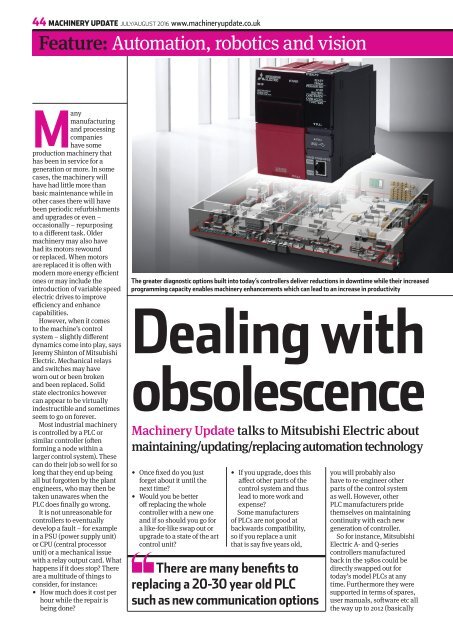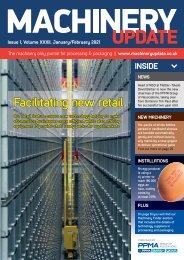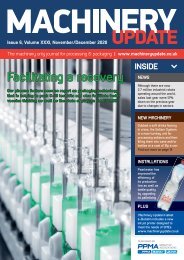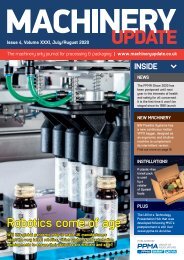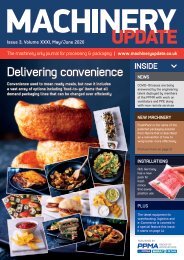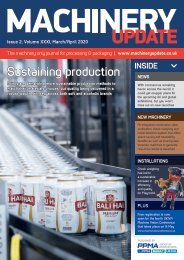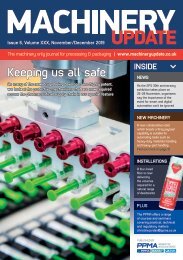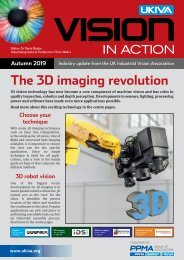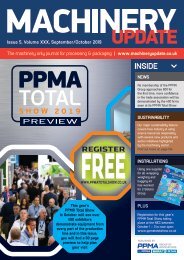MU July / August 2016
Machinery Update Issue 4, Volume XXVII, July / August 2016
Machinery Update Issue 4, Volume XXVII, July / August 2016
Create successful ePaper yourself
Turn your PDF publications into a flip-book with our unique Google optimized e-Paper software.
44 MACHINERY UPDATE JULY/AUGUST <strong>2016</strong> www.machineryupdate.co.uk<br />
Feature: Automation, robotics and vision<br />
Many<br />
manufacturing<br />
and processing<br />
companies<br />
have some<br />
production machinery that<br />
has been in service for a<br />
generation or more. In some<br />
cases, the machinery will<br />
have had little more than<br />
basic maintenance while in<br />
other cases there will have<br />
been periodic refurbishments<br />
and upgrades or even –<br />
occasionally – repurposing<br />
to a different task. Older<br />
machinery may also have<br />
had its motors rewound<br />
or replaced. When motors<br />
are replaced it is often with<br />
modern more energy efficient<br />
ones or may include the<br />
introduction of variable speed<br />
electric drives to improve<br />
efficiency and enhance<br />
capabilities.<br />
However, when it comes<br />
to the machine’s control<br />
system – slightly different<br />
dynamics come into play, says<br />
Jeremy Shinton of Mitsubishi<br />
Electric. Mechanical relays<br />
and switches may have<br />
worn out or been broken<br />
and been replaced. Solid<br />
state electronics however<br />
can appear to be virtually<br />
indestructible and sometimes<br />
seem to go on forever.<br />
Most industrial machinery<br />
is controlled by a PLC or<br />
similar controller (often<br />
forming a node within a<br />
larger control system). These<br />
can do their job so well for so<br />
long that they end up being<br />
all but forgotten by the plant<br />
engineers, who may then be<br />
taken unawares when the<br />
PLC does finally go wrong.<br />
It is not unreasonable for<br />
controllers to eventually<br />
develop a fault – for example<br />
in a PSU (power supply unit)<br />
or CPU (central processor<br />
unit) or a mechanical issue<br />
with a relay output card. What<br />
happens if it does stop? There<br />
are a multitude of things to<br />
consider, for instance:<br />
• How much does it cost per<br />
hour while the repair is<br />
being done?<br />
The greater diagnostic options built into today’s controllers deliver reductions in downtime while their increased<br />
programming capacity enables machinery enhancements which can lead to an increase in productivity<br />
Dealing with<br />
obsolescence<br />
Machinery Update talks to Mitsubishi Electric about<br />
maintaining/updating/replacing automation technology<br />
• Once fixed do you just<br />
forget about it until the<br />
next time?<br />
• Would you be better<br />
off replacing the whole<br />
controller with a new one<br />
and if so should you go for<br />
a like-for-like swap out or<br />
upgrade to a state of the art<br />
control unit?<br />
• If you upgrade, does this<br />
affect other parts of the<br />
control system and thus<br />
lead to more work and<br />
expense?<br />
Some manufacturers<br />
of PLCs are not good at<br />
backwards compatibility,<br />
so if you replace a unit<br />
that is say five years old,<br />
There are many benefits to<br />
replacing a 20-30 year old PLC<br />
such as new communication options<br />
you will probably also<br />
have to re-engineer other<br />
parts of the control system<br />
as well. However, other<br />
PLC manufacturers pride<br />
themselves on maintaining<br />
continuity with each new<br />
generation of controller.<br />
So for instance, Mitsubishi<br />
Electric A- and Q-series<br />
controllers manufactured<br />
back in the 1980s could be<br />
directly swapped out for<br />
today’s model PLCs at any<br />
time. Furthermore they were<br />
supported in terms of spares,<br />
user manuals, software etc all<br />
the way up to 2012 (basically


